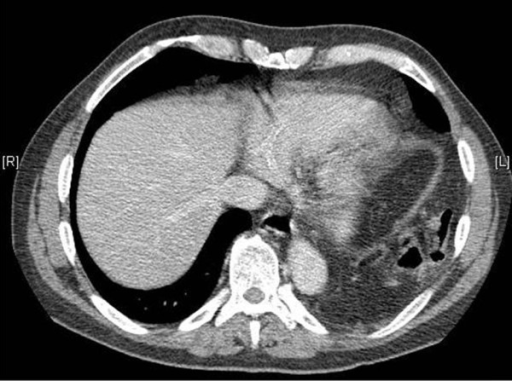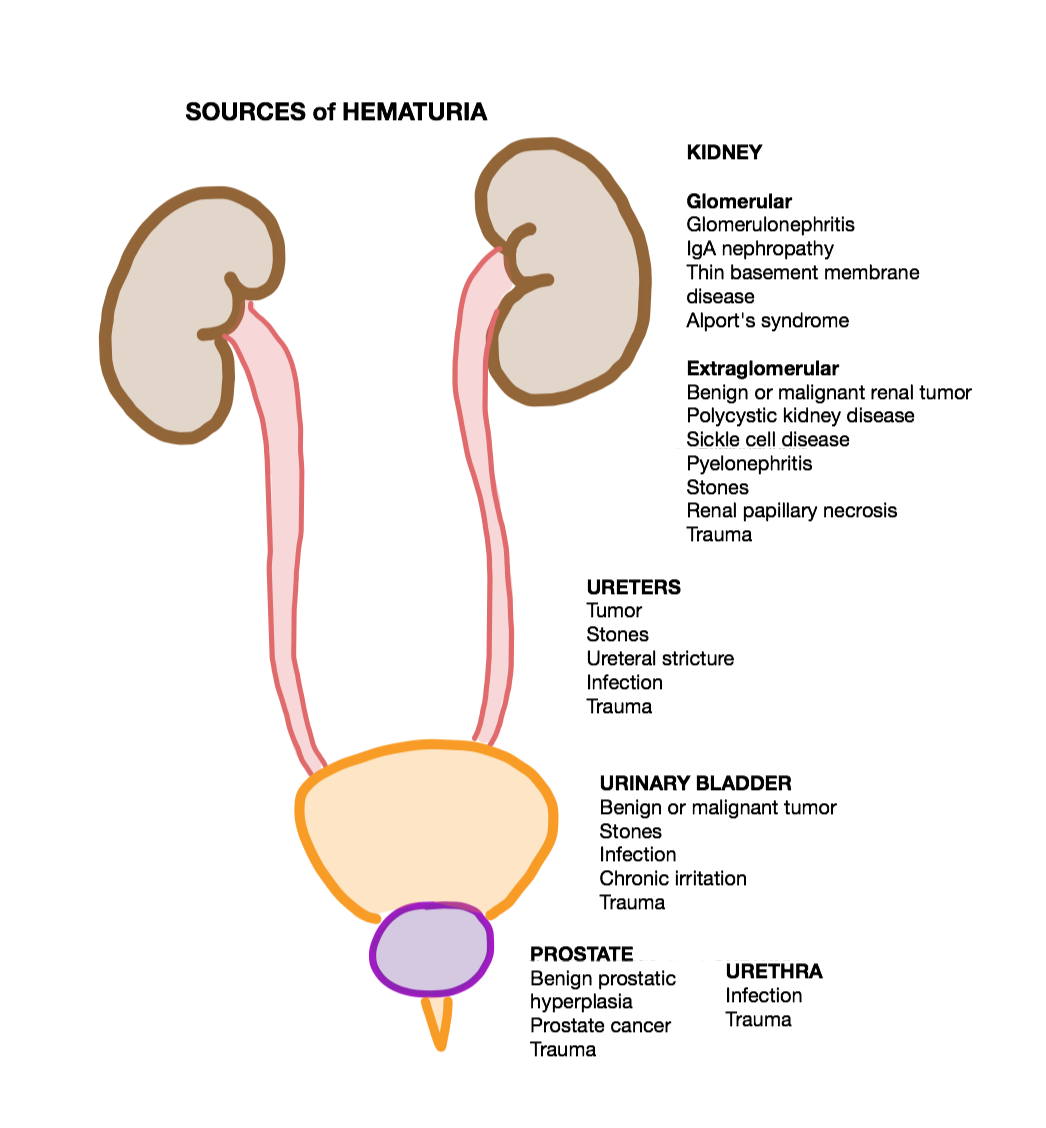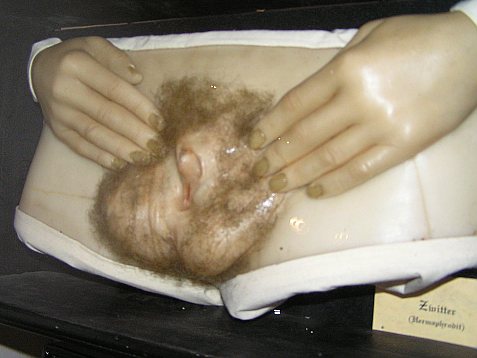|
Renal Ectopia
An ectopic kidney is a kidney that is not located in its usual position ( ectopia) in the lumbar retroperitoneal space. It is the result of anomalous migration of the kidneys from their origin in the fetal pelvis during embryogenesis. The diagnosis is usually made during antenatal and/or postnatal testing, when the ectopic kidney is found incidentally. Although most patients with renal ectopia are asymptomatic, some can develop symptoms due to complications such as kidney stones, urinary tract infections and hydronephrosis. Embryology The kidney arises from the intermediate mesoderm and has three embryological forms: pronephros, mesonephros and metanephros. The pronephros and mesonephros are the primitive transient stages, while the metanephros is the final and functional stage that later forms the permanent kidneys. The metanephros is formed at around fifth to sixth week of gestation and is composed of the metanephric mesenchyme (the proper kidney) and the ureteric bud (co ... [...More Info...] [...Related Items...] OR: [Wikipedia] [Google] [Baidu] |
Kidney
In humans, the kidneys are two reddish-brown bean-shaped blood-filtering organ (anatomy), organs that are a multilobar, multipapillary form of mammalian kidneys, usually without signs of external lobulation. They are located on the left and right in the retroperitoneal space, and in adult humans are about in length. They receive blood from the paired renal artery, renal arteries; blood exits into the paired renal veins. Each kidney is attached to a ureter, a tube that carries excreted urine to the urinary bladder, bladder. The kidney participates in the control of the volume of various body fluids, fluid osmolality, Acid-base homeostasis, acid-base balance, various electrolyte concentrations, and removal of toxins. Filtration occurs in the glomerulus (kidney), glomerulus: one-fifth of the blood volume that enters the kidneys is filtered. Examples of substances reabsorbed are solute-free water, sodium, bicarbonate, glucose, and amino acids. Examples of substances secreted are hy ... [...More Info...] [...Related Items...] OR: [Wikipedia] [Google] [Baidu] |
Diaphragmatic Rupture
Diaphragmatic rupture (also called diaphragmatic injury or tear) is a tear of the diaphragm, the muscle across the bottom of the ribcage that plays a crucial role in breathing. Most commonly, acquired diaphragmatic tears result from physical trauma. Diaphragmatic rupture can result from blunt or penetrating trauma and occurs in about 0.5% of all people with trauma. Diagnostic techniques include X-ray, computed tomography, and surgical techniques such as an explorative surgery. Diagnosis is often difficult because signs may not show up on X-ray, or signs that do show up appear similar to other conditions. Signs and symptoms include chest and abdominal pain, difficulty breathing, and decreased lung sounds. When a tear is discovered, surgery is needed to repair it. Injuries to the diaphragm are usually accompanied by other injuries, and they indicate that more severe injury may have occurred. The outcome often depends more on associated injuries than on the diaphragmatic injury i ... [...More Info...] [...Related Items...] OR: [Wikipedia] [Google] [Baidu] |
Hematuria
Hematuria or haematuria is defined as the presence of blood or red blood cells in the urine. "Gross hematuria" occurs when urine appears red, brown, or tea-colored due to the presence of blood. Hematuria may also be subtle and only detectable with a microscope or laboratory test. Blood that enters and mixes with the urine can come from any location within the urinary system, including the kidney, ureter, urinary bladder, urethra, and in men, the prostate. Common causes of hematuria include urinary tract infection (UTI), kidney stones, viral illness, trauma, bladder cancer, and exercise. These causes are grouped into glomerular and non-glomerular causes, depending on the involvement of the glomerulus of the kidney. But not all red urine is hematuria. Other substances such as certain medications and some foods (e.g. blackberries, beets, food dyes) can cause urine to appear red. Menstruation in women may also cause the appearance of hematuria and may result in a positive urine dips ... [...More Info...] [...Related Items...] OR: [Wikipedia] [Google] [Baidu] |
Urinary Incontinence
Urinary incontinence (UI), also known as involuntary urination, is any uncontrolled leakage of urine. It is a common and distressing problem, which may have a significant effect on quality of life. Urinary incontinence is common in older women and has been identified as an important issue in geriatric health care. The term enuresis is often used to refer to urinary incontinence primarily in children, such as nocturnal enuresis (bed wetting). UI is an example of a stigmatized medical condition, which creates barriers to successful management and makes the problem worse. People may be too embarrassed to seek medical help, and attempt to self-manage the symptom in secrecy from others. Pelvic surgery, pregnancy, childbirth, attention deficit disorder (ADHD), and menopause are major risk factors. Urinary incontinence is often a result of an underlying medical condition but is under-reported to medical practitioners. There are four main types of incontinence: * Urge incontinence ... [...More Info...] [...Related Items...] OR: [Wikipedia] [Google] [Baidu] |
Vesicoureteral Reflux
Vesicoureteral reflux (VUR), also known as vesicoureteric reflux, is a condition in which urine flows retrograde, or backward, from the urinary bladder, bladder into one or both ureters and then to the renal calyx or kidneys. Urine normally travels in one direction (forward, or anterograde) from the kidneys to the bladder via the ureters, with a one-way valve at the vesicoureteral (ureteral-bladder) junction preventing backflow. The valve is formed by oblique tunneling of the distal ureter through the wall of the bladder, creating a short length of ureter (1–2 cm) that can be compressed as the bladder fills. Reflux occurs if the ureter enters the bladder without sufficient tunneling, i.e., too "end-on". Signs and symptoms Most children with vesicoureteral reflux are asymptomatic. Vesicoureteral reflux may be diagnosed as a result of further evaluation of hydronephrosis, dilation of the kidney or hydroureter, ureters draining urine from the kidney while in utero as well a ... [...More Info...] [...Related Items...] OR: [Wikipedia] [Google] [Baidu] |
Uterine Septum
A uterine septum is a congenital uterine malformation where the uterine cavity is partitioned by a longitudinal septum; the outside of the uterus has a normal typical shape. The wedge-like partition may involve only the superior part of the cavity resulting in an ''incomplete septum'' or a ''subseptate uterus'', or less frequently the total length of the cavity (''complete septum'') and the cervix resulting in a double cervix. The septation may also continue caudally into the vagina resulting in a " double vagina". Signs and symptoms The condition may not be known to the affected individual and not result in any reproductive problems; thus normal pregnancies may occur. In more serious cases have reported high infertility rates. However, it is associated with a higher risk for miscarriage, premature birth, and malpresentation. According to the classical study by Buttram there is a 60% risk of a spontaneous abortion, this being more common in the second than in the first tri ... [...More Info...] [...Related Items...] OR: [Wikipedia] [Google] [Baidu] |
Bicornuate Uterus
A bicornuate uterus or bicornate uterus (from the Latin ''cornū'', meaning "horn"), is a type of müllerian anomalies, Müllerian anomaly in the human uterus, where there is a deep indentation at the Uterus#Structure, fundus (top) of the uterus. Pathophysiology A bicornuate uterus develops during embryogenesis. It occurs when the proximal (upper) portions of the paramesonephric ducts do not fuse, but the distal portions that develops into the lower uterine segment, cervix, and upper vagina fuse normally. Diagnosis Diagnosis of bicornuate uterus typically involves imaging of the uterus with 2D or 3D Gynecologic ultrasonography, ultrasound, hysterosalpingography, or magnetic resonance imaging (MRI). On imaging, a bicornuate uterus can be distinguished from a septate uterus by the angle between the cornua (intercornual angle): less than 75 degrees in a septate uterus, and greater than 105 degrees in a bicornuate uterus. Measuring the depth of the cleft between the cornua (fundal ... [...More Info...] [...Related Items...] OR: [Wikipedia] [Google] [Baidu] |
Unicornuate Uterus
A unicornuate uterus represents a uterine malformation where the uterus is formed from only one of the paired Müllerian ducts while the other Müllerian duct does not develop or only in a rudimentary fashion. The sometimes called hemi-uterus has a single horn linked to the ipsilateral fallopian tube that faces its ovary. Signs and symptoms Women with the condition may be asymptomatic and unaware of having a unicornuate uterus; normal pregnancy may occur. In a review of the literature Reichman et al. analyzed the data on pregnancy outcome of 290 women with a unicornuate uterus. 175 women had conceived for a total of 468 pregnancies. They found that about 50% of patients delivered a live baby. The rates for ectopic pregnancy was 2.7%, for miscarriage 34%, and for preterm delivery 20%, while the intrauterine demise rate was 10%. Thus patients with a unicornuate uterus are at a higher risk for pregnancy loss and obstetrical complications. Cause The uterus is normally formed durin ... [...More Info...] [...Related Items...] OR: [Wikipedia] [Google] [Baidu] |
Cryptorchidism
Cryptorchidism, also known as undescended testis, is the failure of one or both testes to descend into the scrotum. The word is . It is the most common birth defect of the male genital tract. About 3% of full-term and 30% of premature infant boys are born with at least one undescended testis. However, about 80% of cryptorchid testes descend by the first year of life (the majority within three months), making the true incidence of cryptorchidism around 1% overall. Cryptorchidism may develop after infancy, sometimes as late as young adulthood, but that is exceptional. Cryptorchidism is distinct from monorchism, the condition of having only one testicle. Though the condition may occur on one or both sides, it more commonly affects the right testis. A testis absent from the normal scrotal position may be: # Anywhere along the "path of descent" from high in the posterior (retroperitoneal) abdomen, just below the kidney, to the inguinal ring # In the inguinal canal # Ectopic, havin ... [...More Info...] [...Related Items...] OR: [Wikipedia] [Google] [Baidu] |
Hypospadias
Hypospadias is a common malformation in fetal development of the penis in which the urethra does not open from its usual location on the head of the penis. It is the second-most common birth defect of the male reproductive system, affecting about one of every 250 males at birth, although when including milder cases, is found in up to 4% of newborn males. Roughly 90% of cases are the less serious distal hypospadias, in which the urethral opening (the Urinary meatus, meatus) is on or near the head of the penis (Glans penis, glans). The remainder have proximal hypospadias, in which the meatus is all the way back on the shaft of the penis, near or within the scrotum. Shiny tissue or anything that typically forms the urethra instead extends from the meatus to the tip of the glans; this tissue is called the urethral plate. In most cases, the foreskin is less developed and does not wrap completely around the penis, leaving the underside of the glans uncovered. Also, a downward bending of ... [...More Info...] [...Related Items...] OR: [Wikipedia] [Google] [Baidu] |
Adrenal Gland
The adrenal glands (also known as suprarenal glands) are endocrine glands that produce a variety of hormones including adrenaline and the steroids aldosterone and cortisol. They are found above the kidneys. Each gland has an outer adrenal cortex, cortex which produces steroid hormones and an inner Adrenal medulla, medulla. The adrenal cortex itself is divided into three main zones: the zona glomerulosa, the zona fasciculata and the zona reticularis. The adrenal cortex produces three main types of steroid hormones: mineralocorticoids, glucocorticoids, and androgens. Mineralocorticoids (such as aldosterone) produced in the zona glomerulosa help in the regulation of blood pressure and osmoregulation, electrolyte balance. The glucocorticoids cortisol and cortisone are synthesized in the zona fasciculata; their functions include the regulation of metabolism and immune system suppression. The innermost layer of the cortex, the zona reticularis, produces androgens that are converted to ... [...More Info...] [...Related Items...] OR: [Wikipedia] [Google] [Baidu] |
Ectopic Ureter
Ectopic ureter (or ureteral ectopia) is a medical condition where the ureter, rather than terminating at the urinary bladder, terminates at a different site. In males this site is usually the urethra, in females this is usually the urethra or vagina. It can be associated with renal dysplasia, frequent urinary tract infections, and urinary incontinence (usually continuous drip incontinence). Ectopic ureters are found in 1 of every 2000–4000 patients, and can be difficult to diagnose, but are most often seen on CT scans. Ectopic ureter is commonly a result of a duplicated renal collecting system, a duplex kidney with 2 ureters. In this case, usually one ureter drains correctly to the bladder, with the duplicated ureter presenting as ectopic. The embryology that explains the pathology of an ectopic ureter is a cephalad origin of the ureteral bud on the mesonephric duct. With an abnormally long common excretory duct, the ureter never becomes incorporated into the bladder, and, th ... [...More Info...] [...Related Items...] OR: [Wikipedia] [Google] [Baidu] |










